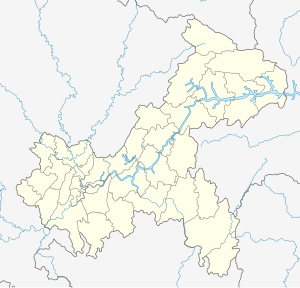Jinfoshan
| Jinfoshan 金 佛山 |
||
|---|---|---|
|
South side of Jinfoshan |
||
| height | 2238 m | |
| location | Chongqing , People's Republic of China | |
| Dominance | 2238 km | |
| Coordinates | 29 ° 4 ′ 0 ″ N , 107 ° 18 ′ 0 ″ E | |
|
|
||
| Type | Rock peaks | |
| rock | Karst rock | |
The Jinfoshan or Jinfushan ( Chinese 金 佛山 , Pinyin Jīnfú Shān - "Golden Buddha Mountain") is a mountain range in the northern section of the Dalou Mountains ( Daloushan ) in the southeastern district of Nanchuan of the government- direct city of Chongqing in the People's Republic of China . Since 2014 the mountain range has been part of the UNESCO World Natural Heritage " Karst Landscapes in South China ".
description
The Jinfoshan is part of a mountain range that covers about 1300 km². 552 km² of this is designated as a nature reserve and a further 441 km² as a natural attraction. The highest peak is Fengcuiling at 2238 m . The Jinfoshan forms a kind of table mountain, the plateau of which has an average height of 2018 m, is interrupted by numerous gorges and has many cliffs. The Jinfoshan mountain range is separated from the neighboring karst landscapes by deeply cut river valleys. The entire mountain region is characterized by great differences in altitude, steep terrain, gorges and many cliffs from 200 to 300 m high. In the area of Jinfoshan, an extensive karst cave system has formed over the last 200-350,000 years, consisting of caves that are partly connected to one another. So far, five caves (Xiannv, Gufo, Lingguan, Yanzi and Jinfo) and 17 kilometers of corridors have been explored. The karst caves are remarkable because of their sometimes extraordinary size. The Jinfo-Yangzi cave system covers an area of over 90,000 m².
The climate corresponds to a monsoon climate with moderate temperatures and abundant rainfall. The annual precipitation is 1396 mm and there are an average of 236 rainy days and 263 days with fog each year. The humidity is 90% and the mountain peaks are often shrouded in fog. Near the summit, the mean annual temperature is 8.3 ° C and in the valleys around 16-18 ° C.
The Jinfoshan lies in the northern subtropics and was not affected by glaciation during the last glacial period in the Quaternary due to its southern location . As a result, the area has become a refuge for many plants from the past and has a relic flora in sections . “ Living fossils ” such as the pigeon tree , the handkerchief tree and rare species such as the primeval sequoia can be found here. A total of 212 plants were families , 741 genera counted and 1,992 species of vascular plants. Numerous plants enjoy official protection status and 53 are endemic here. The nature of Jinfoshan is considered to be relatively untouched. The forest area covers up to 100,000 hectares and 90 percent of the area is covered with forest above 1,400 meters. There are 6,700 hectares of bamboo forest and more than 30 species of mountain rhododendrons . 523 species and 113 subspecies of animals have been identified in the Jinfoshan area . These include rare and protected species such as leopard , clouded leopard , South Chinese Tiger (probably extinct), François' langur , Chinese musk deer , Jinfo Mountain Salamander ( Pseudohynobius jinfo ), and others. Numerous biological species that were first discovered in the vicinity of Jinfoshan bear the biological species epithet jinfoshanensis .
Protection status and entry in the world natural heritage
As early as the 1990s, some individual karst areas in southern China were included in the tentative list of UNESCO World Heritage. While the individual karst areas were initially nominated relatively independently of one another, from 2002 the responsible Chinese authorities pursued the strategy of nominating the various areas in individual phases as part of the world natural heritage " Karst landscapes in southern China ". The first three previously nominated karst areas were included in the UNESCO World Heritage Site under this umbrella term. In the second preparatory phase, which began in 2013, a total of four karst areas were nominated, including Jinfushan. The nominated area comprised 6744 ha with a buffer zone of 10,675 ha. The World Heritage criteria (vii) and (viii) were cited as justification . At its 38th meeting in Doha ( Qatar ) from June 15 to 25, 2014, the World Heritage Committee included the mountain region as part of the karst landscapes in southern China in the UNESCO World Heritage List.
Web links
- Website about the Jinfushan (Engl./chin.)
Individual evidence
- ↑ Jinfushan Scenic Spot. UNESCO website, 2019, accessed on July 23, 2019 .
- ↑ a b c Nomination 1248bis (inscribed extension). UNESCO website, 2019, pp. 86–113 , accessed on July 23, 2019 (English).
- ↑ Zongxian Han, Hu Gang, Shaobin Wu, Chan sliding Cao, Xin Dong: A census and status review of the Endangered François' langur Trachypithecus francoisi in Chongqing, China . In: Oryx . tape 47 , no. 1 . Cambridge University Press, Jan 8, 2013, pp. 128-133 , doi : 10.1017 / S0030605311001396 (English).
- ↑ Wenchi Jin, Yan Chen: Jinfo Shan Nature Reserve — a hidden Chinese treasure . In: BirdingASIA . tape 16 , 2011, p. 15–25 (English, online [PDF]).
- ↑ WHC-14 / 38.COM / 16. (pdf) UNESCO, July 7, 2014, accessed on July 30, 2019 .


